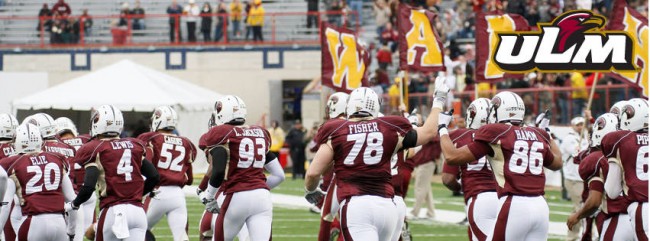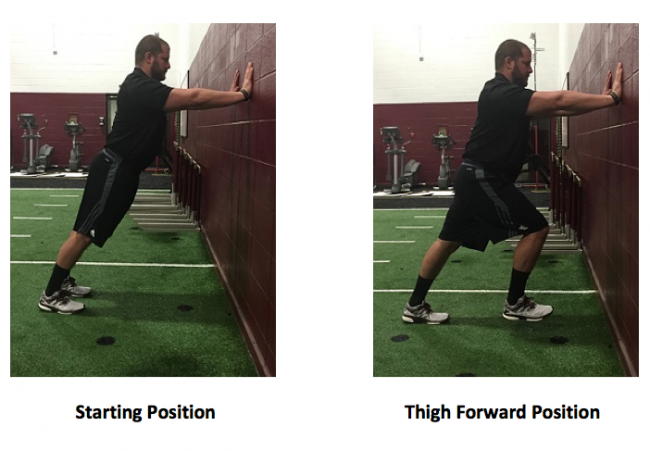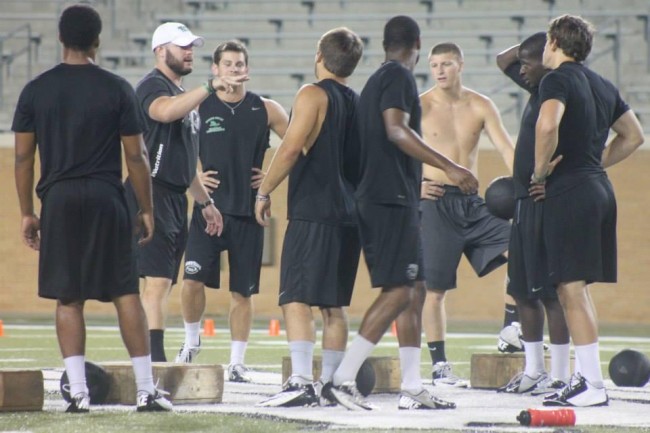
Building off my last article, I would like to talk about the actual tools involved with the programming of speed development, specifically acceleration. My last article covered the foundation for speed development and went over the tools that can be used for setting your athlete up to begin speed development. Foundational movements such as throws, jumps and wall drills will be used throughout the speed development process. In this article, I'll expand on the use of those foundational tools, specifically for an acceleration phase of training, and introduce sprinting aids that help with the development of power and technique.
Warm Up
As stated in the previous article, the warm up is a great tool for developing general physical preparedness (GPP) and aerobic capacity. The warm up should be used to enhance all biomotor abilities such as strength and power, neuromuscular coordination, speed and agility, balance and stability, flexibility and mobility and energy system development or what we know as "fitness." Within the warm up, you can use corrective exercises and running technique drills to further enhance the biomechanical efficiency of your athletes. The warm up needs to challenge the athlete to work on neuromuscular coordination. With the goal of preparing the athlete for the work ahead, the warm up needs to be well thought out to challenge the athlete.
Before doing any type of training, the first thing we want to do is activate the stabilizing musculature of the torso. This helps to prevent injury by activating the transverse abdominus, multifidus and obliques. Not only will athletes build the core strength needed for stabilization during sprinting, but they will develop core strength for all other athletic movements as well. Following activation, athletes can begin in-place mobility targeting the hips, hamstrings, groin, glutes, soleus, gastrocnemius and upper body including the torso, arms, chest and back. Following activation and mobility, coaches can begin with the movement preparation session of the warm up. The athlete should constantly be moving throughout the course of the entire warm up, with the goal of completing the warm up as quickly, efficiently and technically sound as possible. The warm up should last around 20 minutes and decrease in time as GPP increases.
Football is an alactic/aerobic sport, meaning that we’re dependent on how fast our body can regenerate adenosine triphosphate (ATP). When ATP is regenerated through aerobic processes, energy homeostasis is maintained and a given power output can be sustained for a long period of time. This is why tempo runs on recovery or low intensity days and GPP during the warm up are very important. They aid in building aerobic capacity and help the body recover energy substrates much faster. The same thing comes into play during speed development. The ultimate tradeoff between maximum power and high endurance is determined by the athlete’s ability to regenerate ATP through aerobic and anaerobic means.
 Photo courtesy of ULM Athletics
Photo courtesy of ULM Athletics
Program Overview
A successful speed training program will utilize throws, jumps, wall drills and sprints to elicit neural and physical changes within the body. This must be performed in conjunction with your resistance training program. The correct sequencing of movements within a training session is very important for eliciting a neural response from the lowest to highest neural threshold. With this order, we have gradually increased neurological firing and we will be able to capitalize on that during the sprints.
Medicine Ball Throws
We'll start with explosive strength/starting strength using medicine ball training because this carries over to acceleration and starting strength. Starting strength plays a very important role in the initial stages of acceleration, from starts to the first 3–5 yards of pure acceleration. (Pure acceleration involves higher ground contact and less air time.) During the throws, the athlete will use a three-count pause during the loading phase of each perspective exercise (eccentric phase) before creating as much force and power during the concentric phase of the movement, which correlates to the force displacement during the start and first 3–5 yards of pure acceleration (starting strength).
With any speed training that focuses on explosive strength and starting strength, we always want to start with acceleration development as our first block. Remember, explosive strength is a precursor to reactive strength, which is used in top-end speed. So it doesn't make any sense to start with reactive strength if we haven't built a base of explosive strength with our athletes. The volume of loading should be high to build explosive strength. Use one set of 10 reps per each throw. A 10- to 12-pound ball can be used for these exercises, and once an explosive base has been established, a 16-pound ball may be introduced. Stay with explosive strength for at least four weeks, as this is the typical length of an acceleration phase of sprint development. Try and perform these throws 3–4 times per week. You may undulate the volume if you want, alternating between 10 reps one day and five reps the next.
Jumps
Beginners such as incoming freshmen or those new to speed development will start with explosive strength development through jumps just as they did for throws. As stated in the previous article, before doing any type of jumping, athletes need to have a basic understanding of jump mechanics and be able to perform them efficiently. Broad jumps and triple broad jumps can be used for starting strength and are used to support the transition phase of running (the abrupt deceleration of the thigh).
Wall Drills
Wall drills are great for pure acceleration mechanics as well as proper body position, correct shin angle, posture, violent thigh action and violent negative acceleration. Progress the athlete slowly with wall drills. Start with single leg punches, single switches and double switches. Make sure the athlete holds a proper position throughout the entire exercise with the hips forward, the back leg straight and the heel slightly off the ground, a big chest, head up and the foot slightly above the ground with the heel under the thigh and the toe slightly in front of the knee
 One major deficiency that coaches need to be aware of is “short changing,” which refers to limiting the full drive of the thigh forward. This mainly occurs when working double switches, triple switches or continuous switches.
One major deficiency that coaches need to be aware of is “short changing,” which refers to limiting the full drive of the thigh forward. This mainly occurs when working double switches, triple switches or continuous switches.
Sprints
Work one skill at a time. Don't work acceleration and top-end speed qualities within the same training block. Acceleration will be used for top-end speed, meaning acceleration development is used to teach the athlete to reach top-end speed much quicker using the tools above and to also use good technique. Acceleration will consist of longer ground contact time, hence the use of explosive strength, and shorter air time. Mechanics should be the main focus for the first 2–4 weeks when introducing speed work. Use buildups or technical buildups to work the acceleration phase building up to a full sprint. Even though we are working acceleration, we want the athlete to still open up and run using good acceleration technique. After all, if we want to increase the speed of an athlete, we have to train above 95 percent effort to elicit any neurological change.
In the vast majority of non-track sports or sports played on a field, court or ice, sprint actions are limited to short accelerations, most of which are less than 30 meters (32 yards). Although it takes the average athlete about 60 meters to reach true top-end speed, if we train at these distances, we will limit the number of quality reps we can achieve throughout a training process as well as increase the exposure to injury. Keeping the distance to 30 meters allows the athlete to acquire more meaningful reps throughout the training process and concentrate on acceleration technique.
If we're looking to stay in the alactic realm of training, the distance needs to be kept to fewer than 40 yards (37 meters), as this keeps us under the glycolytic lactic zone. The key principle to keep in mind is we are trying to develop high speed output within sport. We aren't trying to get our athletes ready to run the 100-meter race. A training distance of 30 meters is more than enough distance to work acceleration and build top-end speed. In terms of recovery from each sprint, it is recommended that you allow a minute to a minute and a half between each run as well as 2–5 minutes between each set.
Sprint Aids
There are numerous tools that we can use to aid in the development of speed. Tools such as hills, sleds and vests can be used as accommodating resistance just like bands and chains for dynamic effort work.
Hills
Hill inclines should be no greater than 40 degrees. The use of the hill forces the athlete to maintain the correct acceleration position and allow for better front side mechanics because it forces the thigh to continually drive forward.
Sleds
Sleds provide a similar benefit as the hills because they force the athlete to maintain a good acceleration position while placing less stress on the hamstrings. Sleds involve more power output. However, the sled doesn't diminish the athlete's speed by a wide margin, so loading parameters may still be somewhat high. Typically, the sled is used to work initial acceleration. Most beginners start off with a weighted 10-yard sled acceleration run. Depending on the weight of the sled, coaches should start the athlete off with just a 10-pound plate and work up to a 25-pound plate.
The goal of the acceleration phase is to focus on using our technique from the wall drills by driving the thigh through and keeping the foot low during our first 3–5 yards of sprinting. Pure acceleration is very important during this distance. Whether we are pulling a sled or sprinting up a hill, it is imperative to work good acceleration technique in the first 3–5 yards and continue to allow the thigh to come forward as we transition over to top-end speed mechanics. Although we aren't working on top-end speed mechanics, we can cue the athlete to keep the thigh driving forward, creating good front side mechanics.
General Tips
Contrasting certain types of sprint aids can help in priming the nervous system for top-end speed runs. For example, use sled acceleration with an open charge. When using a sled before top-end speed runs, we can work pure acceleration and then allow the athlete to hit a non-weighted run immediately after. This allows the athlete to work acceleration for a predetermined distance and then quickly use that technique to reach top-end speed in a non-weighted run.
Summary Points
- Acceleration will be the first quality of sprint development.
- When programming for speed acceleration, starting strength and explosive strength will be trained together.
- Acceleration possesses explosive qualities that can be trained through certain throws and certain types of jumps.
- This allows us to train the athlete in how to develop more force through the ground, which helps with acceleration. Remember, acceleration consists of longer ground contact time and less air time.
- We can contrast sprint aids throughout the week. On one day, we can use sleds, and on the other, we can use a hill.
- To truly increase speed, we must work speed development at least 3–4 days per week.
- Pure acceleration lasts the first 3–5 yards of a sprint.
Closing Thoughts
The tools discussed above can all be used for acceleration development. It can't be stressed enough that acceleration is the first step in the continuum of speed. Due to the high neuromuscular coordination demanded by top-end speed, acceleration and the training qualities associated with it must be developed first before starting top-end speed training. We can flip flop between the two, meaning four weeks of acceleration and four weeks of top-end speed with a deload week in between. However, acceleration must come first.











World Class sprinters reach top speed between 60-70m, it really has to do with time not distance; each athlete reach different top speeds at different time and distances.
Higher top speed longer acceleration pattern.
Ofcourse each athlete is different but we are not dealing with world class sprinters in the game of football. These articles are not for track athletes they are for field sports. Acceleration mechanics as in pure acceleration mechanics last the first three two five yards. The article discusses the mechanics of the running phase as they are important for reaching the end goal of top end speed quicker.
I recommend you seek out reading material from Ralph Mann and Loren Seagrave as they are the premiere sprint coaches in the world who I have been lucky to learn from.
If you want to get technical you would break it down to acceleration, transition, top end speed, this article is meant to simplify training for speed as it is a mis understood concept when training for. Field sports are a game of acceleration. This is no way is geared towards track and field.